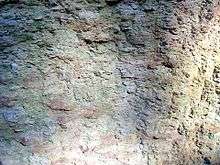Wianamatta shale

Wianamatta Shale is a geological feature of the Sydney Basin, New South Wales, Australia. The Wianamatta Group is made up of the following units (listed in stratigraphic order):
The Wianamatta Group directly overlies the older (but still Triassic in age) Hawkesbury sandstone. (The shales generally comprises fine grained sedimentary rocks such as shales and laminites with less common sandstone units.
Note: Wianamatta is spelt according to the way it sounded when spoken by the original Aboriginal people when questioned by the Rev. William Branwhite Clarke. Any reference to any other spelling sourced in the "trove" article in the Sydney Morning Herald is a typographical error.
Depositional environment
The Wianamatta Group has been inferred to represent a cycle of basin infilling associated with the migration of a large delta front from west to east. The Ashfield Shale was deposisted in a low energy marine environment and preserves laminated silty sediments. The Minchinbury Sandstone comprises a set of sandy barrier islands at the former shoreline. The Bringelly Shale was deposited in a swampy alluvial plain with meandering streams flowing from the west forming discontinuous beds of sandstone.[1]
Weathering
Weathering of the shale units produces a rich clayey soil, often with poor drainage, such as that in the Cumberland Plain.[2] These clay soils are recognised as being reactive with appreciable Shrink-swell capacity.
Low lying areas where groundwater is close to the surface are also susceptible to dryland salinity. Groundwater quality can range from fresh to highly saline, with the deeper groundwater generally less saline.
Other rock types found in the Sydney Basin include the Narrabeen shale, Mittagong formation, Illawarra Coal Measures, Newcastle Coal Measures, and Shoalhaven Group.